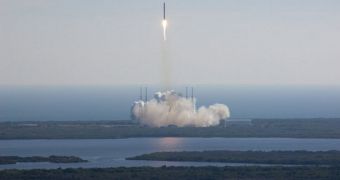Officials at the Hawthorne, California-based Space Exploration Technology Corporation (SpaceX) announce big plans for their Dragon space capsule, which made its maiden flight on December 8.
The spacecraft is the first privately-built and owned capsule to launch to space aboard a private rocket, demonstrate orbital capabilities, reenter Earth's atmosphere without burning, and then landing softly in the Pacific Ocean with the help of parachutes.
The demonstration flight took place from the Cape Canaveral Air Force Station (CCAFS), in Florida, where the company has control of Launch Complex 40, Space reports.
SpaceX is operating under a $1.6 billion contract it signed with NASA, under the Commercial Orbital Transportation Services (COTS) program. One of the terms in the agreement was that it launches the first demon flight for the Dragon by the end of 2010.
The company needs to prove the capsule's technologies in a total of three flights, which means that only two remain to be completed successfully before the Dragon is allowed to go to the International Space Station (ISS).
Resupplying the ISS is the main reason the COTS program exists. The three remaining NASA shuttles will be retired in 2011, and America will be left without access to space for its astronauts for the first time since the beginning of its space program.
But, before the company is allowed to take its spacecraft anywhere near to the $100 billion ISS, it must conduct a wide range of surveys and calibrations to improve its functionality.
“The first thing we're going to do is examine the spacecraft very, very closely. We're going to do deep forensics on it to see, did anything break? Is there any place we should be, perhaps, strengthening?” said on Wednesday Elon Musk.
The official is the CEO of SpaceX and also a co-founder of the PayPal online payments service.
But he also added that the corporation is aiming to use Dragon for planetary explorations as well. A few years from now, the capsule will get thrusters that will allow it to land on the surface of another planet, and then take off again.
“There's no meaningful difference in the complexity between the maneuvers we conducted today, and what we would conduct in going to the space station,” Musk also added at the conference.
“Of course, we need to carefully examine the data from this mission and make sure it's all good, but I'm optimistic that the next flight will be to the space station,” he added.
Following the successful launch, NASA Administrator Charles Bolden released a statement congratulating SpaceX on its important achievement.

 14 DAY TRIAL //
14 DAY TRIAL //